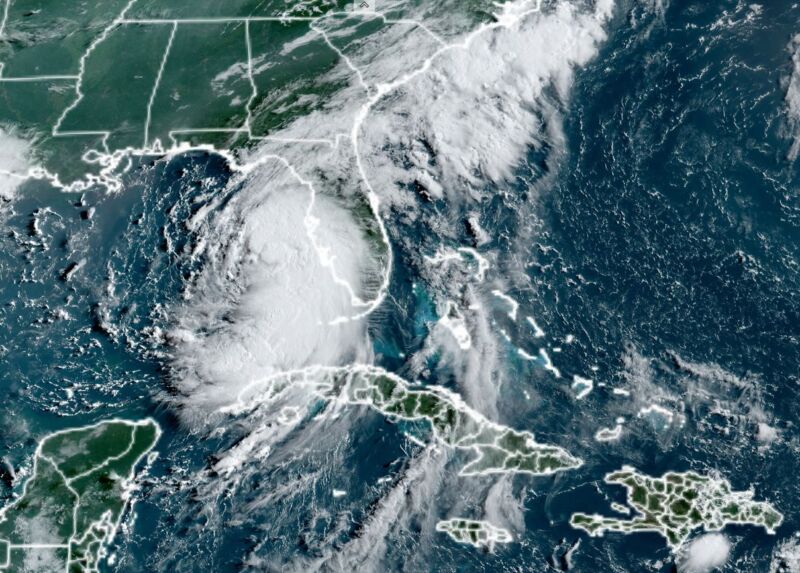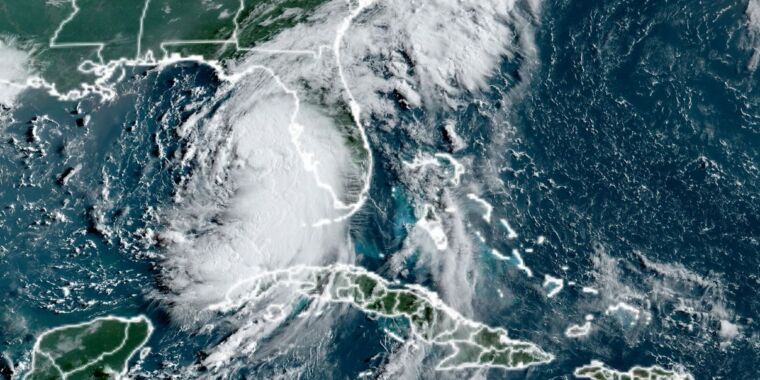
NOAA
As often happens in July, the Atlantic tropics were in a lull after Hurricane Beryl hit Texas and the short-lived Tropical Storm Chris moved into Mexico. But now, with the African dust dwindling from the atmosphere and August well underway, the oceans are waking up.
Tropical Storm Debby formed over the weekend and is expected to reach Category 1 hurricane status before making landfall along the west coast of Florida on Monday, according to National Hurricane Center meteorologists.
As far as hurricanes go, this isn’t the most threatening storm the Sunshine State has seen in recent years. Sure, no one likes hurricanes, or the storm surge they bring. But Debby is likely to hit a relatively sparsely populated area of Florida, where it will take much of its wrath out on reserves and wildlife areas. That won’t be pretty, but as hurricanes go, this one should be fairly manageable from a wind and tide perspective.
Major flooding storm expected
But there is a much bigger threat from Debby that will continue to unfold in the southeastern United States well into next week: a major flooding storm. Historic flooding is likely in areas of Florida, Georgia and South Carolina.
Debby is moving fairly well toward the north-northwest Sunday morning, at 13 mph. This is a fairly common path for hurricanes that race along the edge of high pressure areas. Then, when they gain enough latitude, as Debby is doing now, they turn toward the poles and eventually move toward the northeast.

Debby is expected to be on the road again next week.
National Hurricane Center
And that is exactly what Debby will likely do through Monday. However, after that time, it looks like the high pressure building over the central Atlantic will be strong enough to block Debby’s escape route to the northeast. If that happens, it will trap the storm near the Georgia and Carolina coasts for two to three days.
There is still a lot of uncertainty about where Debby will go after it hits Florida. It will likely cross Georgia on Tuesday and then its center could re-enter the Atlantic Ocean. Either way, its center will likely be close to or just offshore. From there, it will be able to tap into very warm seas, in the 83 to 85 degree Fahrenheit range.
In such a pattern, with a nearly stationary storm, rain bands can be continually replenished by moisture drawn in from the ocean. This produces intense tropical rainfall and “training” where a band of rainfall becomes more or less stationary over a certain area, fed by moisture from the coast.
Because it’s still a few days before this pattern forms, and because of the uncertainty in Debby’s path, we can’t say exactly where the heaviest rains will occur. However, the Weather Prediction Center, the branch of the National Weather Service charged with forecasting rainfall amounts, is predicting some pretty staggering totals for the period from now through Friday.

WeatherBell
From Savannah, Georgia, north through Hilton Head Island and Charleston, South Carolina, the Weather Prediction Center is predicting accumulations of 20 to 25 inches, with higher totals possible in some areas. Additionally, it's possible for these high rainfall totals to extend dozens of miles inland.
The African wave train is starting to roll
Parts of Florida and North Carolina could also see extremely heavy rainfall in the coming days due to uncertainty over Debby's action.
And that’s not all. As we get deeper into August, tropical waves are starting to shoot off the west coast of Africa. One of these is now approaching the Windward Islands and should move into the Caribbean next week. There, it has a good chance of developing into a tropical storm or more. This is likely to be the start of a period of frenetic activity that characterizes August, September, and the first half of October in the Atlantic tropics.
All of this is in line with meteorologists’ expectations for an exceptionally busy Atlantic hurricane season. This is due to both an abnormally warm Atlantic Ocean (seas fueled by climate change are at unprecedented highs in the modern era) and the looming development of La Niña in the Pacific, which is creating favorable conditions for hurricane development in the Atlantic basin, including the Caribbean Sea and the Gulf of Mexico.

